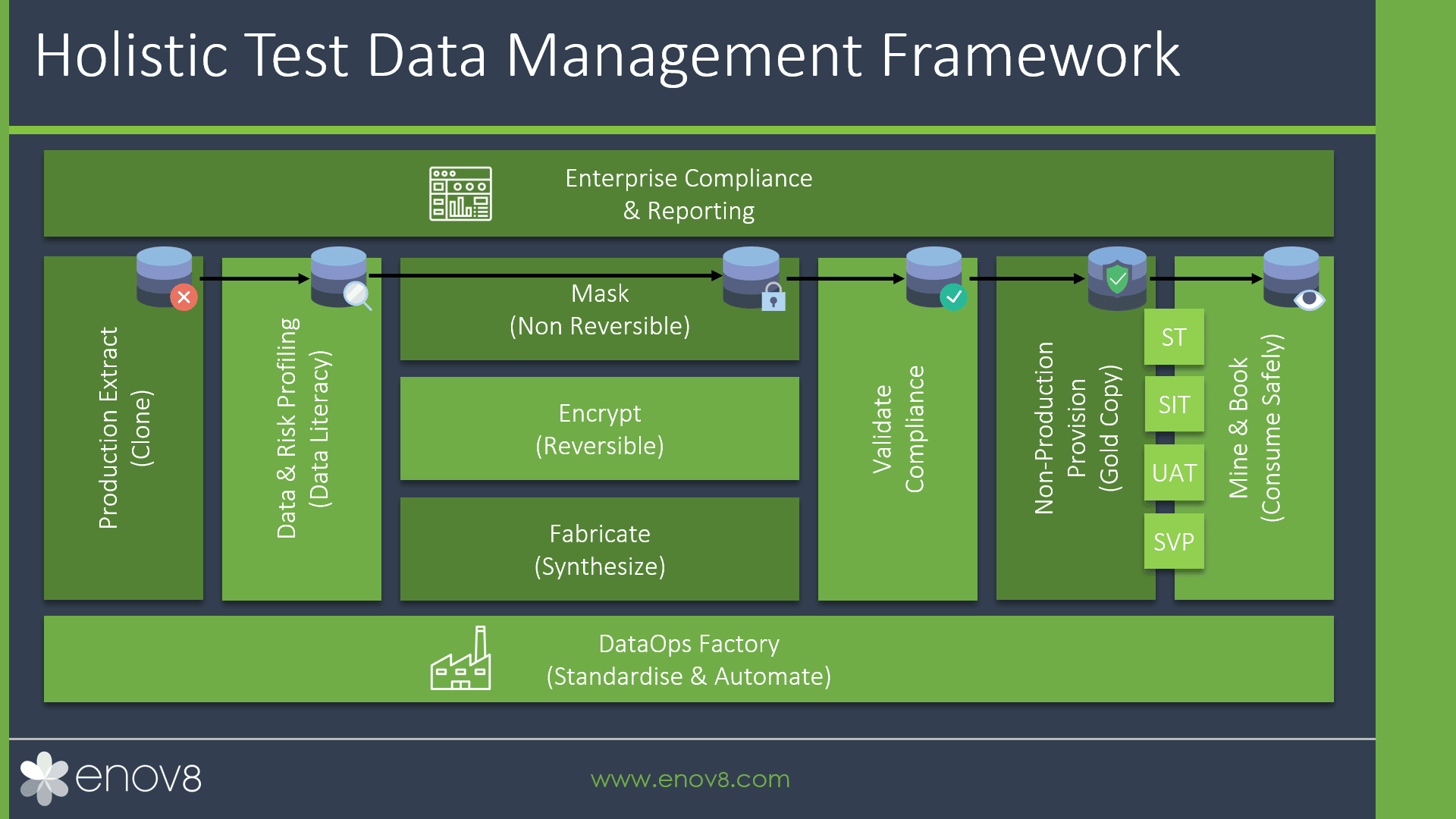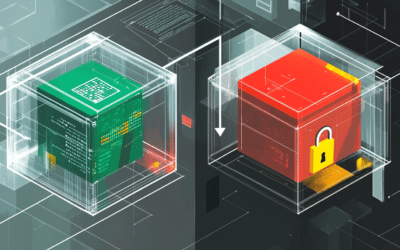
The Perfect TDM Balance : Fake & Masked Real Data
December, 2023
by Jane Temov.
Jane Temov is an IT Environments Evangelist at Enov8, specializing in IT and Test Environment Management, Test Data Management, Data Security, Disaster Recovery, Release Management, Service Resilience, Configuration Management, DevOps, and Infrastructure/Cloud Migration. Jane is passionate about helping organizations optimize their IT environments for maximum efficiency.
In the ever-evolving landscape of software development and testing, one crucial component often stands as the linchpin between success and failure: test data. Test Data serves as the lifeblood of quality assurance, enabling developers and testers to scrutinize software applications for vulnerabilities, errors, and optimal functionality. However, the journey from concept to deployment is not without its challenges, with questions of data privacy, accuracy, and realism looming large on the horizon.
Innovate with Enov8
Test Data Manager
*aka ‘Data Compliance Suite’
The Data Securitization and Test Data Management platform. DevSecOps your Test Data & Privacy Risks.
In this examination of Test Data Management (TDM), we explore the nuanced world of generating, protecting, and using test data. We discover how an innovative method that blends the creativity of synthetic data with the protective measures of masked real data can lead to exceptional advancements in test data practices. Central to this is the pivotal choice between masked real data and synthetic data.
The Role of Test Data in Software Testing
In the realm of software development, testing is a critical phase that ensures the final product meets user expectations and functions flawlessly. At the heart of effective software testing lies test data. This is the information, both inputs and expected outputs, that is used to assess how a piece of software performs under various conditions.
Why Test Data Is Essential:
- Comprehensive Coverage: Test data is indispensable for achieving comprehensive test coverage. It enables the evaluation of various scenarios, from routine operations to edge cases and error conditions. Without diverse and representative test data, it’s impossible to assess how well software will perform in the real world.
- Bug Identification: Test data helps uncover bugs, glitches, and inconsistencies in software. By subjecting an application to different input data, testers can identify issues related to data handling, processing, and functionality. This proactive approach to bug identification saves time and resources compared to addressing problems post-deployment.
- Performance Assessment: Software testing involves evaluating not only correctness but also performance. Test data provides the basis for assessing how well a system handles different workloads, data volumes, and concurrent users. Without realistic test data, it’s challenging to predict how the software will perform in production.
Identifying Potential Issues Before Deployment
- Early detection of issues: Test data allows for early detection and resolution of issues, preventing costly and reputation-damaging problems from emerging in the production environment.
- Reducing post-deployment risks: By thoroughly testing with representative data, organizations can minimize the risks of software failures, data breaches, and security vulnerabilities after deployment.
The Challenges of Test Data Management
While the importance of test data is undeniable, managing it effectively presents numerous challenges. Here, we delve into the complexities and limitations associated with test data management:
Using Real Production Data for Testing:
- Data Privacy Concerns: One of the primary challenges is dealing with sensitive and confidential information. Using real production data in testing can inadvertently expose personal or sensitive details, leading to privacy breaches and potential legal ramifications.
- Data Consistency: Production data is often dynamic and constantly changing. Test environments require consistent and stable data for meaningful testing. Synchronizing and maintaining consistent real data in a testing environment can be a logistical nightmare.
Data Masking and Privacy Regulations:
- Data Masking: To address privacy concerns while still using real data, data masking has emerged as a crucial technique. Data masking involves obfuscating or altering sensitive information in a way that retains the data’s format and structure while rendering it useless to unauthorized individuals.
- Privacy Regulations: In today’s data-centric world, privacy regulations like GDPR (General Data Protection Regulation) and HIPAA (Health Insurance Portability and Accountability Act) impose strict guidelines on the handling and protection of personal and sensitive data. Failure to comply can result in hefty fines and damage to an organization’s reputation.
Effective test data management requires navigating these challenges and finding innovative solutions that strike a balance between realistic testing and safeguarding sensitive information.
Fake Data vs. Real Data: Pros and Cons
As we delve deeper into the intricacies of test data management, it’s essential to weigh the advantages and disadvantages of two primary approaches: using fake data and relying solely on real data for testing.
Advantages of Using Fake Data:
- Data Privacy Assurance: Fake data, fabricated data, eliminates concerns related to data privacy. Since it is entirely fabricated, there is no risk of exposing sensitive or confidential information, ensuring compliance with privacy regulations.
- Predictable and Controlled: Fake data provides complete control over the testing environment. Testers can create specific scenarios and edge cases, ensuring consistent and reproducible testing conditions.
- Unlimited Variations: With fake data, there are no limitations on the variations and scenarios that can be tested. Testers can simulate extreme conditions, rare events, or unique scenarios that may be challenging to replicate with real data.
Disadvantages of Using Fake Data:
- Lack of Realism: The primary drawback of fake data is its lack of realism. While it can mimic data structures and formats, it may not accurately represent the intricacies and complexities of real-world data.
- Limited Real-world Validation: Fake data may not uncover issues that are specific to real-world data interactions. Testing solely with fake data may overlook potential problems that could arise when the software encounters genuine user-generated data.
Advantages of Using Real Data:
- Real-world Validation: Testing with real data provides an opportunity to validate how the software performs with actual user-generated data. It can uncover issues that might not be apparent when using fake data.
- High Realism: Real data reflects the actual complexities and nuances of the production environment, making it valuable for assessing real-world performance and behavior.
Disadvantages of Using Real Data:
- Data Privacy Risks: The use of real data carries inherent data privacy risks, as mentioned earlier. Mishandling or exposing sensitive information can lead to severe consequences.
- Data Consistency: Maintaining a consistent and up-to-date copy of real data for testing can be challenging and resource-intensive.
In practice, the ideal approach often lies in finding a balance between fake data and real data, leveraging the strengths of each while mitigating their respective weaknesses.
The Power of Data Masking
In the realm of test data management, data masking emerges as a potent solution to address the challenges associated with using real data while safeguarding data privacy. Data masking involves the transformation of sensitive information within datasets, rendering it unidentifiable and unusable by unauthorized individuals.
The Concept of Data Masking:
- Data De-identification: Data masking techniques include methods such as tokenization, encryption, and data substitution. These techniques ensure that sensitive data elements are replaced with fictitious but structurally similar data, maintaining the format and relationships within the dataset.
- Preserving Data Relationships: Effective data masking not only obscures individual data points but also ensures that the relationships between data elements remain intact. This is crucial for maintaining the functionality of the application during testing.
Role in Protecting Sensitive Information During Testing:
- Compliance with Privacy Regulations: Data masking aligns with privacy regulations by ensuring that sensitive data is never exposed in its original form during testing, thus mitigating privacy risks.
- Safe Testing Environments: It enables organizations to create safe and controlled testing environments where testers can work confidently with datasets without fear of data breaches.
Data masking acts as a bridge between the need for realism in testing and the imperative of data privacy. In the following section, we will explore how combining fake data with masked real data can offer a holistic solution that overcomes the limitations of both approaches.
Blending Fake Data with Masked Real Data
As we navigate the complex landscape of test data management, a strategic approach emerges that leverages the strengths of both fake data and masked real data. This approach involves blending the two to create a harmonious testing environment that balances realism and data privacy.
Benefits of Combining Fake Data and Masked Real Data:
- Realistic Scenarios with Privacy: By combining the ingenuity of fake data and the security of masked real data, organizations can create realistic testing scenarios while ensuring the protection of sensitive information.
- Comprehensive Testing: Testers gain the ability to conduct comprehensive testing that reflects the complexities of real-world data interactions. This approach allows for the identification of issues specific to real data without compromising privacy.
- Flexibility and Control: Blending these two types of data provides flexibility and control. Organizations can choose where to use real data and where to incorporate fake data, depending on the testing objectives and privacy considerations.
Creating the Balance:
- Data Mapping: Careful mapping of real data elements to their corresponding masked or fake counterparts is essential. This mapping ensures that the relationships and dependencies within the data remain intact.
- Selective Use: Determine which parts of the data need to be masked and which can be replaced with fake data. The balance should align with the organization’s privacy policies and the testing goals.
Ensuring Realism without Compromising Privacy:
- Scenario Diversity: Organizations can create a wide range of test scenarios that encompass real-world complexities without exposing sensitive data. This approach enables more accurate predictions of how the software will perform in the field.
- Privacy Assurance: With the use of data masking, privacy concerns are addressed, and organizations can confidently carry out testing activities without risking data breaches or regulatory non-compliance.
Best Practices for Test Data Management
Effective test data management is essential for achieving optimal testing outcomes. Here, we outline a set of best practices that organizations can follow to streamline the process of test data generation, masking, and storage while maintaining data quality and consistency.
Data Generation:
- Data Reusability: Create reusable test data sets to save time and resources. Well-structured, reusable data sets enable consistent testing across different scenarios.
- Data Variation: Generate diverse data sets to cover a wide range of testing scenarios. Variability in data helps identify and address different application behaviors.
Data Masking:
- Granularity Control: Determine the level of granularity for data masking. Some data elements may require more extensive masking than others based on their sensitivity.
- Audit Trails: Implement audit trails to track data access and usage during testing. This ensures accountability and compliance with privacy regulations.
Data Storage:
- Secure Storage: Store test data securely, ensuring that only authorized personnel have access. Encryption and access controls should be in place to protect sensitive data.
- Data Refresh: Regularly refresh / provision test data to ensure it remains relevant and up-to-date. Stale or outdated data can lead to inaccurate testing results.
Data Quality and Consistency:
- Data Validation: Validate test data for accuracy and consistency before and after masking. Data quality is crucial for reliable testing outcomes.
- Data Governance: Establish data governance practices to maintain data integrity throughout the testing lifecycle.
By adhering to these best practices, organizations can navigate the complexities of test data management effectively, ensuring that their testing processes are both robust and compliant with data privacy regulations.
Tools and Solutions for Test Data Management
In the dynamic landscape of software testing, having the right tools and solutions can significantly enhance test data management efficiency and effectiveness. Various software applications and platforms have emerged to address the challenges associated with test data generation, masking, and overall management. One notable solution in this arena is Enov8 TDM.
Enov8 TDM – Revolutionizing Test Data Management:
- Comprehensive Data Management: Enov8 TDM provides an all-encompassing platform for test data management. It facilitates various processes including data generation, masking, provisioning, and data booking management, streamlining the entire test data lifecycle.
- Data Masking and Compliance: The platform ensures robust data masking capabilities, crucial for safeguarding sensitive information. This feature is particularly important for compliance with data privacy regulations, allowing organizations to conduct safe testing without exposing sensitive data.
- Data Bookings: Enov8 TDM enhances the efficiency of data bookings. It simplifies the reservation and provisioning of test data, ensuring its availability for testing teams as required.
- Integration and Automation: With seamless integration capabilities, Enov8 TDM works harmoniously with existing testing tools and environments. This integration facilitates the automation and orchestration of test data provisioning and masking.
- Data Profiling and Analysis: The tool also excels in data profiling and analysis, providing valuable insights into test data. This enhances the development of more effective testing strategies.
Other Test Data Management Tools:
- Delphix: Delphix is another notable player in the test data management space, offering data virtualization and masking solutions for secure and efficient test data management.
- Informatica TDM: Informatica provides a comprehensive test data management platform that includes data profiling, masking, subsetting, and synthetic data generation.
- IBM InfoSphere Optim: IBM’s InfoSphere Optim offers a range of test data management capabilities, including data subsetting, data masking, and test data generation.
Selecting the right test data management tool depends on the specific needs and requirements of your organization.
Conclusion
In the ever-evolving landscape of software testing, the mastery of effective test data management is paramount. The art of striking the perfect equilibrium between fake data and masked real data empowers organizations to scrutinize their software applications with exacting precision while preserving the integrity, privacy, and security of sensitive information. By steadfastly following best practices and harnessing the capabilities of the right tools and techniques, you can elevate your test data management strategy and set the stage for a future filled with successful and secure software deployments.
Relevant Articles
RAG Status: What It Is and Using It for Project Management
Effective Leadership requires effective tooling to drive successful outcomes. One tool they can use to monitor and measure progress is RAG status. RAG stands for Red, Amber, Green, and is a simple traffic light system used to communicate the current status of a...
Enterprise Architecture Tools: 11 to Be Aware Of in 2025
Enterprise architecture (EA) is an essential discipline for organizations aiming to align their IT strategy with business goals. As companies become more complex and technology-driven, having the right set of EA tools is crucial to streamline operations, improve...
What is a Staging Server? An Essential Guide
Release issues happen. Maybe it’s a new regression you didn’t catch in QA. Sometimes it’s a failed deploy. Or, it might even be an unexpected hardware conflict. How do you catch them in advance? One popular strategy is a staging server....
What is Deployment Planning? A Detailed Guide
Deployment planning, sometimes referred to as "implementation planning," is the process of creating a plan for the successful deployment of a new software or system. It involves identifying the resources, tasks, and timeline needed to ensure that the deployment is...
The Definitive Guide to Test Data Generation
Test data generation is a critical part of the software testing lifecycle, ensuring that applications are tested against realistic scenarios before going live. If you’re not testing against production-like data, you’re arguably not truly testing your application. In...
What is a Test Data Manager? A Detailed Introduction
Testing is a critical aspect of software development, and it requires the use of appropriate test data to ensure that the software performs optimally. Test data management (TDM) is the process of creating, storing, and managing test data to ensure its...












